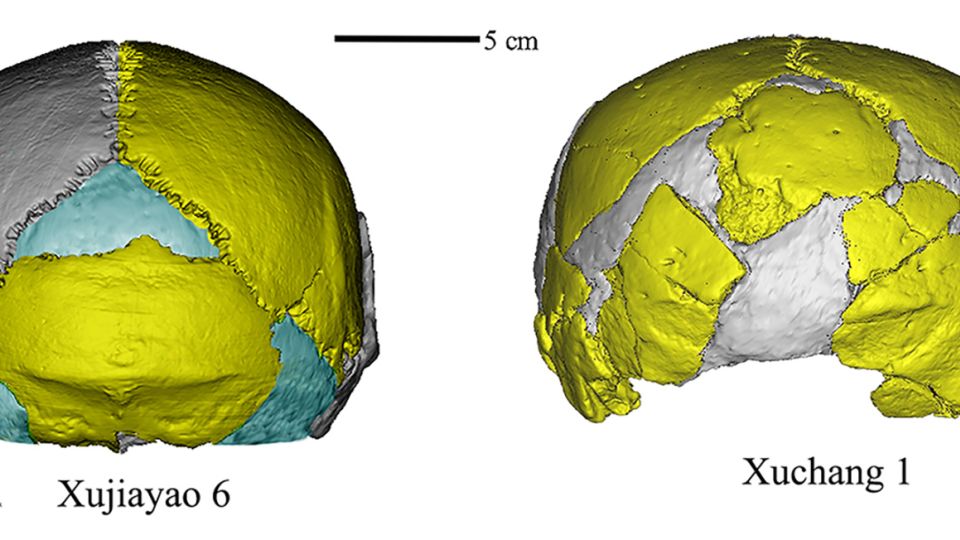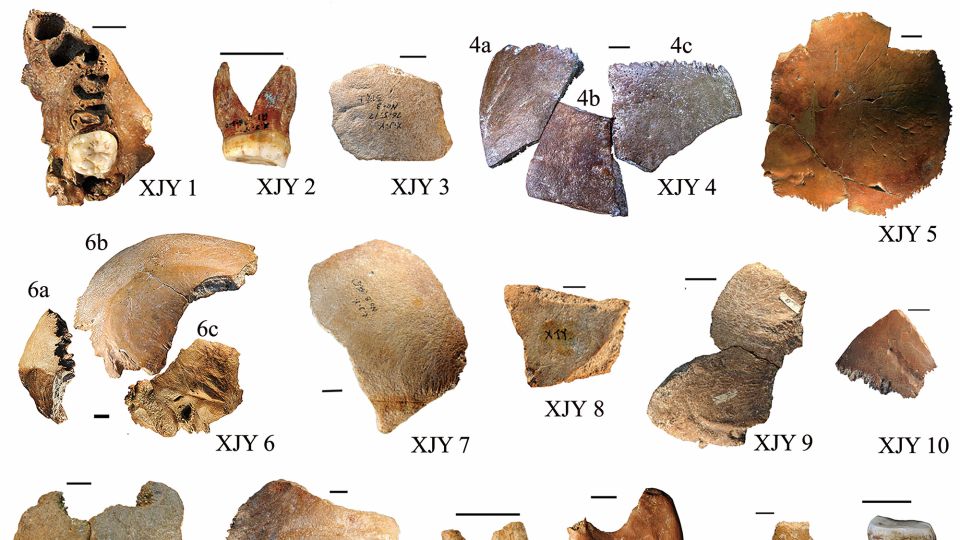Puzzling fossils unearthed in China may rewrite the human story
.
Fossils found in China that resemble human-like features have long puzzled scientists, making it difficult to provide a convincing explanation or classification.
The skull pieces, teeth, jaws, and other remains found at different locations around the nation are undoubtedly leftovers from ancient human-like ancestors, specifically species in the human family tree that dates back 300,000 to 100,000 years ago. However, it's never been clear what exact type of species these bones belonged to or exactly where they fit into a growingly complicated human family tree.
Dr. Christopher Bae, a professor of anthropology at the University of Hawaii at Manoa, who previously worked in Beijing for many years, is among the scientists re-examining these mysterious fossils with new perspectives. Alongside Dr. Wu Xiujie, a senior professor from the Institute of Vertebrate Paleontology and Paleoanthropology in Beijing, he now recommends formally acknowledging an unidentified ancient human species, which they have proposed be formally recognized as a new scientific species.
The most distinctive feature of this newfound human ancestor? A significantly larger brain than that of our species, the only remaining human type, Homo sapiens.
: Homo juluensis, a nod to “ju lu,” which means huge head in Chinese.
″Published in September. ″We have a minimum capacity of roughly 1,350 cubic centimeters, on average, it's around 1,450 (cc). ″It's not one of the largest, but it's significantly more substantial.″
This proposal has sparked controversy among paleoanthropologists, and some scientists are divided on whether this reclassification merits the status of a distinct new species.
This ancient human population represented a distinct group, and scientists have named it the Denisovans.
(Note: However, you asked to the US English, so I kept it in that)

Hiding in plain sight?
In northern China, just above the line between the Shanxi and Hebei provinces, there are remains from the 1970s found at the Xujiayao (Houjiayao) site, but they don't fit easily into one classification. These remains include the fossils of 21 people, dating back 160,000 to 200,000 years.
About nine decades ago recently discovered.
A scientific theory called multiregionalism, which was largely discredited, hypothesized that a human ancestor left Africa roughly 2 million years ago. This theory suggested there was only one type of human ancestor that evolved into modern humans over time.
which suggested discrete ethnic origins for the Chinese people, coincided with nationalist sentiments and was once particularly deeply rooted among Chinese academics.
The widely accepted model today is called the "out of Africa" theory: It's believed that the distant ancestors of modern humans who lived outside of Africa left the continent and eventually spread across the world around 50,000 to 60,000 years ago.
In what is now South Africa, some have suggested that the current situation, in which only one type of human ancestor exists, is unusual.
"Fifty years of fossil discoveries have shown that there was never just one group of human ancestors at any given time, making modern humans particularly unique," said Carrie Mongle, an assistant professor in the anthropology department at Stony Brook University in New York.
“Given this, it's not far-fetched to suggest that the number of species represented by the Asian fossils should be reevaluated — we shouldn't simply group them together.”

Discovering connections — and counterarguments
Bae and Wu digitally rebuilt a skull from the remains. Its size, shape, and breadth were not like any known human ancestor, such as Neanderthals or Homo erectus, and not like the rounded skulls of modern humans, according to the analysis. They then compared those features with other mysterious fossils discovered in the area over the past few years.
reported in 2022, also attributed to Denisovans, as well as those from a jawbone discovered in an antique shop in Taiwan back in 2008, known as the Penghu mandible.
Bae and Wu agree that the fossil fragments should be categorized as Homo juluensis. Bae admitted that suggesting the inclusion of the Denisovan remains would stir up controversy, but he believes his team has presented a strong argument.
We believe most people will agree with us that these fossils should be grouped together, and by rule of priority, they should be assigned to juluensis," Bae said. "I think it's just that this new information is so unexpected, people are having trouble understanding our proposal.
However, Mongle and other paleoanthropologists say it's too early to definitively group the Denisovan remains with the fossils from Xujiayao and classify them as a new species called Homo juluensis.
"This team wants to name a new species based mainly on the shape of the skull, but since there are no complete Denisovan fossils to compare, it's too early to group these fossils together," said Ryan McRae, a paleoanthropologist at the Smithsonian National Museum of Natural History, who was not involved in Bae and Wu's research.

McRae's second objection was the scarcity of genetic data available, a criterion that is being used more frequently when classifying species.
Generally, archaeologists make major finds when a trowel strikes a skull or other distinctive bone within a cave. However, the Denisovans were the first ancient human to be confirmed in a lab due to advancements in the analysis of ancient DNA, which makes them quite mysterious.
All the Denisovan remains discovered so far are broken into fragments - none are unique enough to be considered a distinct species, such as Homo sapiens or Homo neanderthalensis. Usually, but not always, a skull is the representative specimen of a new species because it has defining characteristics.
We unfortunately can't accurately describe what Denisovans looked like," McRae stated. "Denisovans are mostly known through genetic data, not fossils, so any comparison should include genetic details to better confirm that they've found more of these individuals.

Enter the ‘Dragon Man’
.
”
First mentioned in scientific publications in 2021, the specimen has an interesting history behind it. The skull was discovered in 1933 by a man who was forced to work by the Japanese, who controlled that area of China at the time, along the Songhua River in Harbin, China. He kept the skull hidden at the bottom of a well for over 80 years, revealing its existence just before he passed away.
Stringer stated that his study with Ni indicated that most of the fossils that Bae classified as H. juluensis actually fit the morphology of the Harbin cranium better. Stringer inferred from this that the Xujiayao specimens and the Denisovan remains may all belong to the same group as the Dragon Man, which has officially been named Homo longi.
“Thus the well-preserved Harbin skull would represent an early Denisovan. Ongoing research by other teams suggests the same conclusion. “Stringer added that more research on the Dragon Man is to be published this year.
Monique Scott of Stony Brook University noted that while she concurred that multiple species of ancient humans may have existed in Asia, she also believed that the fossils Bae identified as belonging to the "big heads" resemble the Homo heidelbergensis skull.
I theoretically agree with the concept of multiple hominin lineages in Asia during the Pleistocene era, but I'm still unsure about how distinct these fossils are from the recently identified Homo longi fossils.
In 1978 and 1984, respectively, dinosaurs known as Yutyrannus huali and Therizinosaurus appeared.
What significance do species names hold?
However, there's no official approval process, and whether this species name is adopted or not will depend on whether other researchers agree and start using it in scientific publications.
Ni emphasized that the Denisovans represent one known population of ancient human relatives, and as such, the term shouldn't automatically be applied to others, such as the Xujiayao ancient humans, even if they turn out to be the same type. It's like calling all Europeans Anglo-Saxons, he said.
I firmly disagree with the idea that previous Asian Middle Pleistocene hominins, whether named or unnamed, should be classified as Denisovans, because 'Denisovan' is simply a label for a population, not a classification.
Bae agreed. “A lot of Western paleoanthropologists want to call the Chinese fossils Denisovans,” he said. “For us, however, Denisovans isn’t actually a distinct species.”
The first person or team to have sufficient evidence to confirm the Denisovans as a distinct species has the freedom to give it any name they choose.
There is no official name for Denisovans because scientists don't have a sufficient amount of comparative material to classify them as a new species.
This is beneficial in one sense because it provides the field with time to uncover more fossil evidence of the Denisovans before designating a new species, but on the other hand, it allows those critical fossils to remain available for assignment of a taxonomic classification before sufficient evidence has been gathered.
There is hope among some paleoanthropologists that a formal species name for Denisovans will reflect both the Denisova Cave and the widely used term "Denisovans," McRae said, noting that there is no certainty that this will be the case.
The time period is full of fossil hominins that are "a bit of a mess," he noted. Some look unique, but some have characteristics similar to Neanderthals, and others have features similar to Homo sapiens, and many possess traits from both, McRae said.
"Splitting fossils into species too early could hide the real story of what's happening worldwide at this time. Logistically, it's very hard to reverse a decision to name a species once it's out there, even if it's not well-supported," he said.
An earlier version of this article incorrectly spelled Ryan McRae's name.
To see more news and receive newsletters, create an account.

Post a Comment